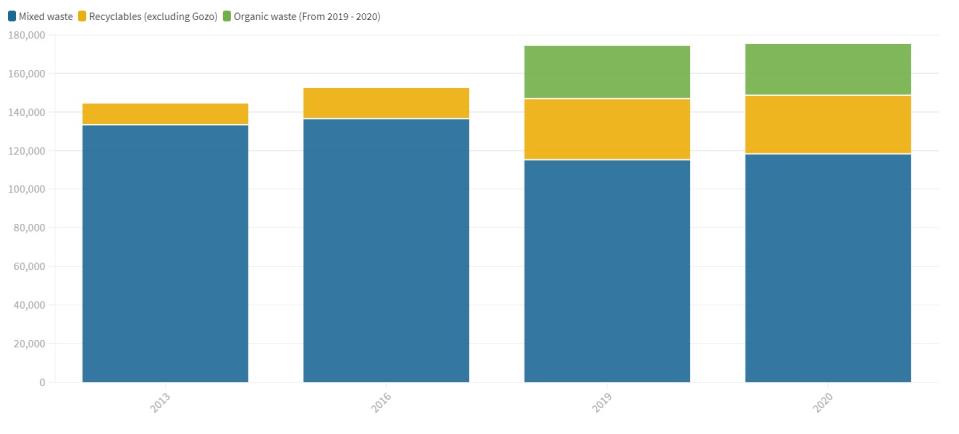St Paul’s Bay and Sliema were the two localities that generated the highest amount of mixed waste in 2020, statistics available on the Wasteserv website reveal.
Both localities have experienced a population boom and saw quite a bit of development over the years. While St Paul’s Bay and Sliema saw an increase in mixed waste generation when compared to 2013 however, the rest of the five highest mixed-waste generating localities - Birkirkara, Mosta and Qormi - saw a reduction.
The Wasteserv statistics provide an overview of waste collection in Malta and Gozo. They show the amount of mixed waste (black bag), recyclables (green and grey bag) and organic (white bag) waste that was delivered to Wasteserv facilities collected from each locality in the country. The statistical information includes the amount in tonnes of such waste and recyclables mainly coming from households, offices and some shops. However, this newsroom understands that the statistics do not include waste coming from certain other kinds of establishments like restaurants, which have their own waste collection agreements; and others that use private schemes. The latter statistics are not available on Wasteserv’s website.
According to the data available, 133,396 tonnes of mixed waste from localities around the country was delivered to Wasteserv facilities back in 2013. This amount rose to 136,586 tonnes in 2016, but then dropped to 115,259 tonnes in 2019. 2020 saw a slight increase over 2019, with the amount rising to 118,316 tonnes.
In terms of organic waste, 27,329 tonnes in total from all localities was received by Wasteserv in 2019, slightly more than the 26,565 tonnes received in 2020. While some localities had been part of the pilot project in earlier years, 2019 and 2020 were the first two full years during which organic waste was collected throughout the country.
In terms of recyclables, not enough data was available for a number of localities in Gozo, so a country-wide analysis was not doable. However on the island of Malta, the data shows that the amount of recyclable waste sent to Wasteserv facilities has doubled since 2016. This is likely due to increased environmental awareness, education campaigns on the issue and could also be partly due to the introduction of the organic waste bag which incentivised recycling even further. In 2013, 10,973 tonnes of recyclable waste was received at Wasteserv facilities from the island of Malta. This amount rose to 15,855 tonnes in 2016 and then doubled to 31,712 tonnes in 2019. It then dropped marginally to 30,389 tonnes in 2020. These amounts refer to the tonnes Wasteserv received through the green/grey recycling bags, but does not mean that all of it could be recycled.
Recently, the National Audit Office published a report about Wasteserv. The NAO report found that in 2019, 58% of plastic waste was still being landfilled. Some 36% was exported (a significant rise over 2016) and 1% was being recycled. The rest was stored. The report, among other things, found that inadequate waste separation at source is leading to recyclable waste being dumped in landfills.
Wasteserv, in reaction to the NAO, had said: “Since the fires that destroyed the Sant’ Antnin Recycling facility, Malta’s recycling performance was severely affected. Such negative trend has now been successfully reversed.” It said that the first weeks of 2021 saw exponential improvements in material recovery. “Looking at plastics alone, the subject of the NAO audit, our facilities are successfully processing a daily average of over 4 tonnes, a figure which continues to improve on a weekly basis.” Wasteserv also said that it too on board a number of the NAO’s recommendations to keep on improving.

Localities with high amounts of mixed waste
The two localities with the highest amount of mixed waste delivered to Wasteserv facilities in the country last year were St Paul’s Bay and Sliema.
9,835 tonnes of mixed waste was collected from St Paul’s Bay and 7,166 tonnes from Sliema in 2020, which is higher than the 7,722 tonnes and 4,384 tonnes collected from the respective localities back in 2013. Both localities have experienced a population increase over the years, and thus an increase in waste is to be expected.
St Paul’s Bay has the largest population out of all localities in the country (32,204 as of 1 January 2020) and Sliema the third highest (24,358). However, one can see that the percentage increase in mixed waste in Sliema since 2013 is far higher than in St Paul’s Bay. The increase could be due to all the offices in the locality.
Birkirkara and Mosta (also high population areas) come in at third and fourth place with 5,197 tonnes and 4,693 tonnes respectively in 2020. In 2013, 7,033 tonnes of such waste was registered as coming from Birkirkara, while 5,762 tonnes came from Mosta, thus meaning that both localities reduced the amount of mixed waste over the years.
Qormi came in 5th, with 4,620 tonnes of mixed waste generated in 2020, down from 5,708 tonnes in 2013.
In terms of recyclables (green/grey bags), all five aforementioned localities registered an increase in 2020 over 2013. St Paul’s Bay ( 2013: 500 tonnes, 2020: 1,794 tonnes), Sliema (2013: 727 tonnes, 2020: 1,282 tonnes), Birkirkara (2013: 586 tonnes, 2020: 1,656 tonnes), Mosta (2013: 534 tonnes, 2020: 1,684 tonnes) and Qormi (2013: 538 tonnes, 2020: 1,325 tonnes).
2013 vs 2020, which localities had the highest percentage reduction in mixed waste?
In percentage terms, the localities which saw the largest percentage reduction in mixed waste in 2020 when compared to 2013 were Santa Lucija (69% less), Mtarfa (56% less), Sannat (55% less) and Gudja (55% less).
The localities with the highest percentage increase in mixed waste in 2020 when compared to 2013 are Sliema (63% more), Marsa (62% more), Rabat (40% more) and Valletta (40% more).
Overall Statistics for Safi were not available.